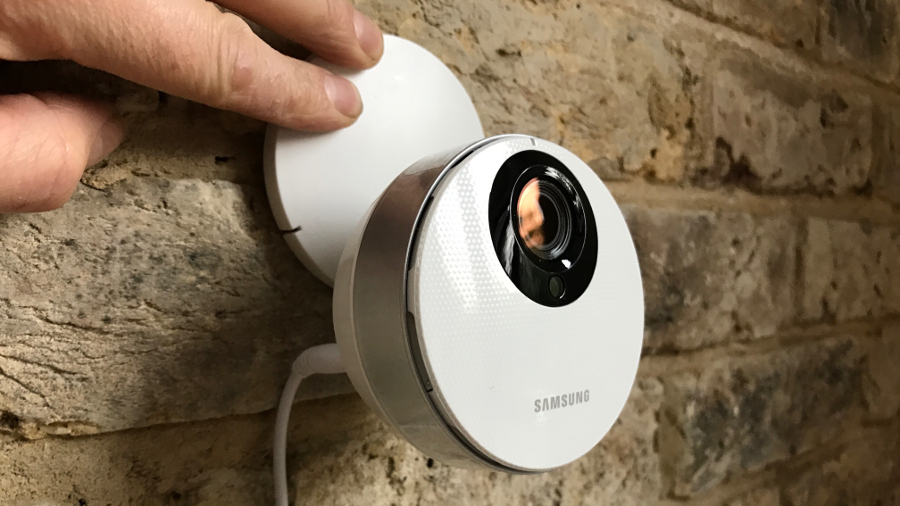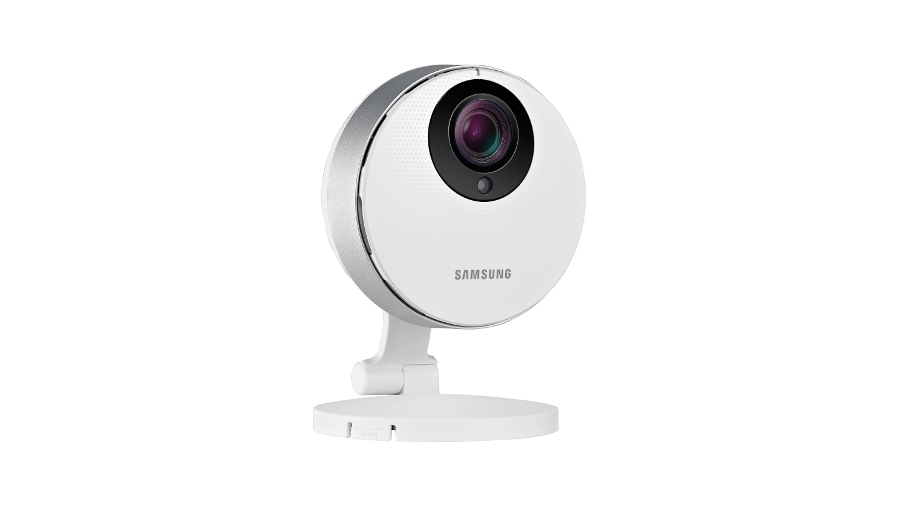TechRadar Verdict
This is a smart-looking camera with some neat features and microSD for local storage of footage, but the build quality, software, and flaky Wi-Fi connectivity let the side down somewhat.
Pros
- +
Ethernet and Wi-Fi connectivity
- +
Local data storage via microSD
- +
Compatible with SmartThings devices
- +
Syncs with Google and Picasa accounts
Cons
- -
Tends to flop forwards on its stand
- -
Feeble plastic construction
- -
Companion app is not intuitive
- -
Picture quality is noisy and grainy
Why you can trust TechRadar
Samsung’s indoor IP camera is often used in conjunction with the company’s SmartThings smart home system, where it can be triggered by a window lock for example, but it also serves very well as a standalone security camera for an office or commercial premises.
Offering Full HD resolution images, two-way audio and a fully articulated mounting bracket, the SmartCam SNH-P6410NB – which retails at £130 (around $160, AU$210) – can be instantly installed to remotely monitor your house or office, sending alerts to your phone when it senses any sound or motion.
Using a decent CMOS sensor, this camera is able to record fairly smooth, clear and natural-looking images in 1080p, or two lower resolutions if you’re worried about your bandwidth. We found that our heavily loaded home network did drop out a few times during testing when in Full HD mode.

Motion sensors will trigger a recording, if you specify that, storing them locally on a microSD card, or storing your footage in the cloud for a fee.
The companion app, called SmartCam, allows you to set up push notifications and gives you a live view of your room (which you can zoom into).
A built-in speaker and microphone enable communication, in case you need to scare off any actual burglars. Alternatively, you can play them one of three tunes, including a lullaby. Okay, this last one isn’t a security feature, it’s in case you want to use the camera as a baby monitor.
Here are the full specs of the SmartCam SNH-P6410NB:
Type: IP camera
Location: Indoor
Mounting: Wall/ceiling bracket included
Connectivity: Wi-Fi/Ethernet
Resolution: 1080p
Night Vision: IR LED
Motion sensor: Yes
Audio: Two-way sound
Battery: No
Local video storage: microSD (up to 64GB)
App support: Android/iOS
Subscription: Free
Size/Weight: 90 x 135 x 40mm (W x H x D); 117g
Design
The simple circular design and glossy white finish makes this compact security camera blend into the background, especially when mounted on a white ceiling.
Sign up to the TechRadar Pro newsletter to get all the top news, opinion, features and guidance your business needs to succeed!
It feels rather lightweight and plasticky, as though it wouldn’t take much to snap the stand, so we’d recommend installing it out of harm’s way. You will only need to accommodate the power cable if you choose to connect via Wi-Fi instead of the bundled Ethernet cable.
The twisting and rotating bracket means you can have every angle covered, while the wide angle of the camera lens generally puts the whole room in view anyway.
Installation and use
This camera is especially easy to set up, thanks to the inclusion of an Ethernet port and cable, which means you don’t need to establish a Wi-Fi connection. However, connecting wirelessly is also made simple by Samsung’s SmartCam app. Download this free app onto your Apple or Android device, sign up to Samsung’s free service and it will walk you through the process of connecting the camera to your Wi-Fi network.

We found that the camera quite often lost its connection with the wireless router, even though they were in the same room, which of course means you lose the feed and the recording, so we would advise making a hardwired Ethernet connection if possible.
The app will also let you specify when you want to be alerted by phone to either movement or noise at the camera’s location. You can also connect it to your Google account to receive emails, or to Picasa if you want to have images automatically uploaded there.
The software isn’t quite as slick and intuitive as the Nest or Netatmo apps, and there’s no ‘timeline view’, but it is fairly easy to navigate. Instead of a scrollable timeline of events, recordings appear in a basic list, or a calendar view for checking back on monthly happenings.
The hardest thing to achieve, via the settings, is how to set up recording schedules and zones of motion activity, which are buried deep in the menu system.
More annoying is the camera’s tendency to lose its wireless connection, as mentioned, and also the constant demand for passwords. You need a password to adjust the app and another to address the camera every time you view it. If you’re signed into your phone, we think that should be enough to check your own camera.

Performance
The video quality available here is quite impressive. Set to 1080p resolution, both live view and recorded clips are clear and bright. The quality drops as you zoom in of course, but it’s still good enough to recognise faces as they pass below the camera. There’s no actual face recognition software here, mind you. That remains the preserve of more sophisticated cameras like the Netatmo Welcome.
What is useful is the way your recordings can be saved onto your phone, or directly onto a microSD card. So instead of paying a monthly fee for storage on Samsung’s cloud servers, footage is held locally, which also feels more secure. The slot can take a 64GB microSD card, although you don’t get a card bundled.
The integration of two-way audio adds some useful functionality, especially if you happen to need a baby monitor, but don’t expect hi-fi quality from the speaker. What you can do, rather surprisingly, is add your own speaker to boost the sound output by using the available mini-jack port. This is a bonus feature that we think few people will actually use.

Jim has been evaluating printers for more than twenty years and has, to date, written over a hundred reviews for TechRadar Pro. From pocket printers to industrial dye sublimation, Jim has been there, run the tests and printed the t-shirt. His expertise extends to consumables (paper, ink, toner) and his printer buying guides make it easy to compare these essential peripherals.
